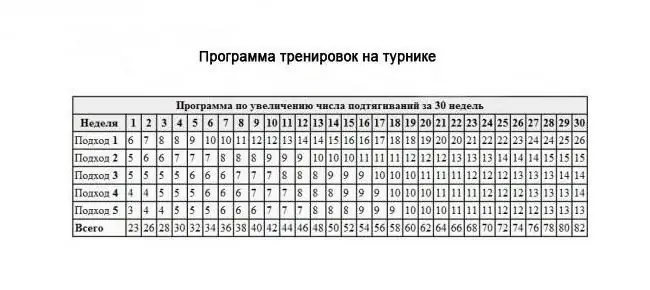Find out how often you need to exercise to actively progress muscle and strength gains. Very often, beginner builders make the same mistake - they choose the wrong training frequency. As a result, they diligently work in the gym, but do not see the desired progress, which leads to disappointment. Many even stop training after that. To prevent this from happening to you, you need to understand how often to train for muscle growth.
Most often, athletes train three times a week, because it is this recommendation that is mainly found on the network. But even if you have the right training program and use the necessary loads, training can be more effective when classes are carried out at the right frequency.
How often should you train?

Sticking to the same training schedule all the time can be a mistake. As you progress, your activities will become more intense and your body will take longer to recover. Research has shown that the average guy who has never exercised before can triple or quadruple his strength through training.
But you must understand that the recovery of the body after physical exertion depends on various factors. The human body is a single mechanism and your health depends on the well-coordinated work of all systems and organs. If muscles can significantly increase their functionality, then, say, the liver does not have this ability. Even the articular-ligamentous apparatus cannot adapt to loads at the same speed as the muscles.
After doing a light workout, you most likely will not feel any major changes, and the body will recover in a short time. A completely different situation develops after an intensive lesson, during which serious working weights were used. In this case, the body may need several days to fully recover.
You must remember that different systems in the body have individual recovery abilities. For example, muscle tissue and glycogen depot can be restored within a couple of days. But the nervous system is so quickly unable to restore its normal performance. For all classes to be effective, it is necessary to find the optimal training method.
Split workouts for muscle growth

Every novice athlete knows about split today. However, if you do not know how often to do training, then split training will not allow you to avoid overtraining. Let's see what this is connected with. There are many options for dividing the body into muscle groups and now we will not talk about them.
Split is a fairly effective scheme for conducting classes, but only with its help you will not be able to solve the problem of a permanent fixed training schedule. It's all about an organ like the kidneys. It doesn't matter to them which muscle group you trained in the last lesson, and which one you will work on now. The kidneys must do their job every day - to utilize metabolites of metabolic processes. Only if a given organ functions well will the body recover. Note that for muscle growth, all systems of our body must be fully restored. By using a split, you make it easier for the kidneys, as they have to do less work. But as you progress, you use all the large working weights, and the question arises again - how often to exercise?
How to Determine the Right Exercise Frequency for Muscle Growth?

Many aspiring builders today are learning a lot of information that can be easily found on the Internet. After that, they are sure that they already know all the secrets of bodybuilding. However, they quickly realize that they were wrong, because progress is not visible.
To make everything clearer for you, we will tell you about one case that happened in real life. One builder stopped progressing and discussed his problem with the coach. As a result, they decided to pause for three weeks.
The guy was serious about bodybuilding and could not stop training for such a long time. First of all, it is quite difficult from a psychological point of view. When you see your progress, it's hard to force yourself to do nothing for three weeks. Sometimes a person may take the advice to stop practicing as a defeat.
However, the body sometimes needs more time to recover and you should keep this in mind. During a long break, you can rethink your approach to building the training process and understand how often to train. Do not think that resting you will be wasting your time. The body uses it for its intended purpose and will be able to fully recover.
However, let us return to the case we are considering. The coach was able to convince his ward and the builder rested for three weeks. Two months after resuming classes, he told the coach about his successes, which turned out to be simply shocking.
The guy was able to increase his strength indicators in a short time and during the first lesson he set personal records in several movements. If earlier he used the most popular three-time training scheme now, then after a break he trains once every nine days. He uses a two-day split, splitting the body into top and bottom. As we expected, the forced pause was good for him.
I would also like to say a few words about how often to do weight loss workouts. This is due to the fact that weight gain has slightly different laws in comparison with fat burning. If your goal is only to fight fat, then classes should be carried out daily, but at the same time it is necessary to correctly build the training process so as not to overtrain. In this case, it makes sense to use anti-catabolics so as not to lose muscle mass. During the drying period, you can recommend conducting no more than two strength training sessions during the week, and devote the rest of the time to cardio sessions.
How to avoid overtraining?

This is an equally important topic compared to how often you do your workouts. First of all, you need to monitor your progress. If you stop progressing in at least one exercise, then this may indicate that you are close to overtraining.
In the example we reviewed above, this happened, because the builder noticed that he had stopped improving his bench press results. If a similar situation has happened to you, then it is worth taking a break. Here are the three main symptoms of overtraining.
- Working weight does not increase in exercises. To progress, you need to gradually increase the load. However, for this, the body must fully recover so that you can work with large weights.
- The number of repetitions or the time of static holding of projectiles does not increase. If the working weight does not increase, then the number of repetitions, or the time of static holding of the projectile, should increase.
- You spend more time doing a similar workout. The effectiveness of training is closely related to the concept of intensity, which is measured in units of time. In simpler terms, if you took longer to do a lesson you did a few days ago today, the intensity has dropped.
Workout Tips for Muscle Growth

If you have made up your training process correctly, then the question of how often to train will not arise. The point is that exercising at any frequency can be effective if you use the right amount. For high-quality muscle pumping, the ideal weekly volume of work for each muscle group for most athletes is 12 sets. Of course, this is an average value and you should determine the effective volume for yourself on an individual basis. The important thing now is for you to get the gist.
- If you train each muscle group only once a week, then you need to do all 12 sets, since the frequency of training is low, you will have to use the entire volume at once.
- When you train each muscle group three times a day, you should do 4 sets for each session, which will result in a weekly training volume equal to 12 sets.
- If you train twice a day, then each muscle group in one lesson should be pumped in six sets.
Note that 12 sets per week is sufficient volume for large muscle groups. For small ones, half of this volume will be enough.
Speaking about how often to train, it is necessary to take into account the training experience of the athlete. For beginners who have been training for less than eight months, a three-day split is perfect.
If you have passed this stage and have been training for more than eight months, then it is worth switching to two-time classes during the week. We recommend that you divide the body into upper and lower halves in this situation.
Many people do not have enough time to visit the gym at least twice a week. As a result, they have to be content with one workout. If you do everything right, then such a strategy will be effective, but definitely not the best. To a greater extent, this frequency of exercise is suitable for maintaining muscle tone. If you want to progress faster, then try to find time for two workouts per week.
How often to train, see this video:






